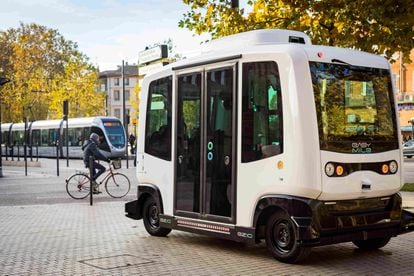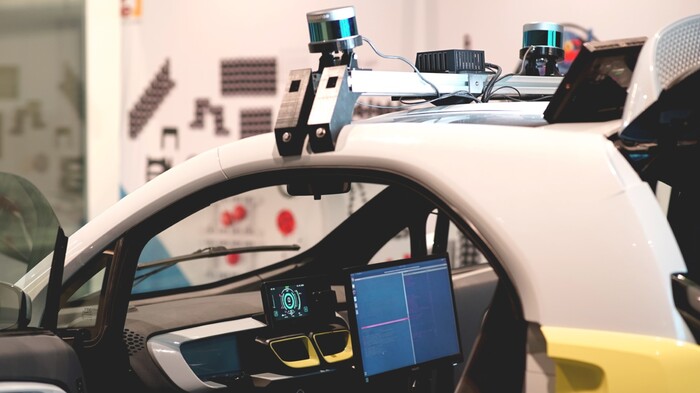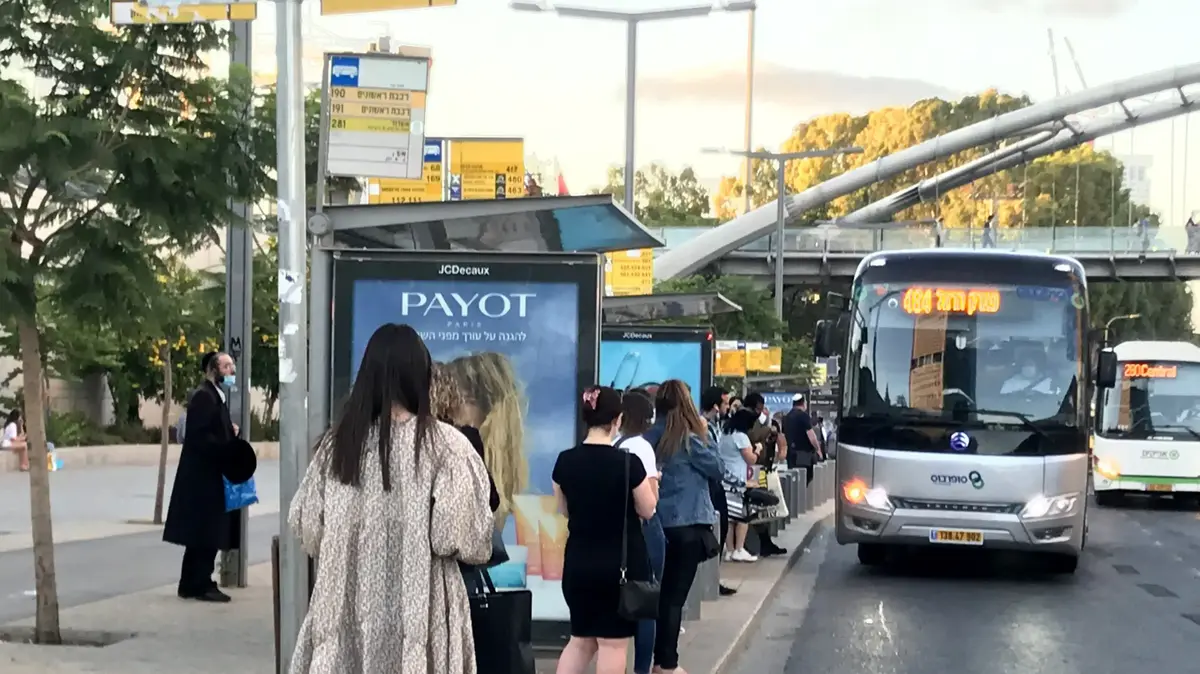Several people look at the new EVA Shutter autonomous vehicle at the It-Trans trade fair in Karlsruhe, Germany, on Friday.
A driverless minibus that connects a residential neighborhood with a suburban station.
An
app
that allows you to ride any means of transport and charges you the cheapest rate at the end of the month.
A tram that takes advantage of its free spaces to deliver parcels.
An individual capsule that makes an urban tour on rails.
A bus that stops at any point in a polygon, even if there is no stop.
All these ideas that we will see in the coming years —in some cases they already work— are the future of public transport, which is trying to reinvent itself after the serious crisis experienced by the pandemic with a great commitment to digitization, decarbonization, transport on demand and the integration of all mobility options on a single platform.
The pandemic has driven the digitization of data from trains, subways, trams and buses, and the challenge now is to integrate all of them with private means (shared cars, motorcycles and bikes), which is known as
mobility as a service
(mobility as a service), which will allow travelers to be offered the best route within the same platform.
"It's an excellent concept that integrates all transport services in one app and makes it possible to book and pay for those services," says Mohamed Mezghani, Secretary General of the International Union of Public Transport (UITP) at the It- trans, held last week in Karlsruhe (Germany) to investigate the future of the sector.
“The key for it to be successful is for the different operators to collaborate by exchanging data, and also for the algorithm to suggest the most sustainable mobility, not just the most profitable for the operator.
It is already beginning to be done in some cities”, he adds.
More information
New mobility and fear of contagion: public transport, in the face of the greatest crisis in its history
"We cannot continue to operate public transport like 20 years ago," explains Marta Serrano, manager of the Valencia EMT and speaker in Karlsruhe.
“We are one of the few sectors that still have prepaid.
It will be necessary to change to a postpaid model in which you use the bus, the metro, commuter trains, bike or shared car and then they give you a bill.
The idea is that you have a personalized card and at the end of the month they bill you for what you have spent, as is already the case with the telephone, electricity and most services”, she continues.
The EVA Shuttle autonomous vehicle.
uitp
Simplifying mobile payments is an idea that will catch on in the coming years and is already working in some German, Austrian and Swiss regions with an app called Fairtiq.
"Our
app
allows you to use all the integrated means of transport (trains, trams, buses) and then charges you the price without having to buy a ticket beforehand, as has happened in most transports up to now," says Gian-Mattia Schucan, Swiss company founder.
Another key will be decarbonisation, that is, abandoning fossil fuels: diesel and gas buses will be replaced by electric fleets in the coming years.
Meanwhile, on-demand public transport will increasingly be an ally in offering more flexible journeys that compete with the car.
Werner Kutil, from Cityway Europe, points out that they have launched a pilot project in the port of Le Havre (France), a huge infrastructure where it is difficult to have good bus frequencies.
For this reason, they have launched a bus line (called Flexilia) that has many stops, but only runs those that have been previously requested through an
app .
, with which they have doubled the number of users and halved the number of kilometers traveled.
“This type of transport is very useful in areas with low population density or during off-peak hours, and it can be a very good complement to public transport.
It will help reduce cars, because it's a flexible way to get around,” says Kutil.
UrbanLoop project to be developed in Nancy.
uitp
Another fundamental improvement will be the updating of the information that travelers receive, which will be increasingly complete and will allow them to better choose their trips.
One example is the Karlsruhe user information portal, which brings together three regions (two German and one French) and already integrates multimobility: it shows all available transport, from buses to bicycles and from trams to trains, and allows you to click on each one of them to see the routes in real time, as well as traffic jams, connections, bike lanes and level of occupation of the car parks.
"The system is available on the screens of public transport stops and also in an
app
, as well as on the web," says Reeg Rihner, an official from Karlsruhe, while showing a complete mobility map of the area.
Driverless buses and individual train pods
In addition to these trends, new inventions that can improve these means of transport will be tested in the coming years, as seen in It-trans.
One of them is autonomous vehicles.
“EVA Shuttle is a driverless minibus equipped with sensors, radars, cameras and an algorithm that processes all the data,” says Henriette Cornet-Show, an expert in autonomous mobility at UITP.
“It is a means of transportation that can work well on university campuses or in neighborhoods with low population density.
Some are being tested on the streets, but in areas with very little traffic.
In a decade we will see them integrated into traffic”, she ventures.
One of these models already works on the Cantoblanco campus of the Autonomous University of Madrid.
Virtual reproduction of the KIT bus platoon project.
uitp
The Karlsruhe Institut of Technology (KIT) has developed a “bus platoon” system whereby a bus without a driver follows the path of another with a driver.
Nicole Rossel, a researcher at the center, explains it this way: “The second bus is equipped with an interface that allows it to follow the first at a short distance.
This second vehicle also has sensors and cameras that send data;
by means of an algorithm, the trajectory is calculated to avoid the obstacles”.
In her opinion, this system could be very useful in the future to reinforce a line at a time of high demand without having to have so many drivers.
For now, they have tested it in a closed circuit, and the next step will be to test it in a city.
“Although it may take people some time to get used to traveling in a self-driving vehicle,” says Rossel.
More futuristic seems the UrbanLoop project of the University of Lorraine (France) and several private companies.
"It is an autonomous electric vehicle that we call individual capsules, which moves on rails, like a small train, and can be used to move one or two people, with room for wheelchairs or bicycles," says Maya Hiba, an engineer project informatics.
As the capsules are small, the system allows for installation with a width of only three meters.
“It is the most efficient transport: it travels a kilometer in a minute for a penny.
It can go 60 an hour,” she continues.
In 2024 they are going to install one of these circuits on the grounds of the Olympic Games in Paris, to link the velodrome and the canoeing circuit, and in 2026 they plan another project in Nancy (France), with a circuit of 3,
5 kilometers along an old abandoned railway, where there will be four stops.
“The idea is to compete with cars where there is no public transport, in areas such as campuses, parks or hospitals.
It is a project to decarbonize and digitize mobility”, he sums up.
Cargo module of the Logiktram project that can be integrated into a tram to carry merchandise
The sustainable distribution of merchandise and its integration with public transport is another of the challenges of the sector.
"LogikTram is a project that seeks to take advantage of trams to carry out logistics distribution in cities," says Michael Frey, principal investigator of this KIT project.
“These are cargo modules with wheels that are attached to the empty places of the trams when they are not full.
The clean energy of the trams is used to move them and, when they arrive at the distribution point, they leave easily and are attached to an electric bicycle, with which the entire distribution is sustainable”.
It will be tested in German cities and hopes to change sustainable last-mile delivery.
"Feminisizing public transport is a matter of social justice"
The mobility expert Marta Serrano, who has participated in the It-Trans congress, founded the Women in Movement association to promote the leadership of women in public transport, a very masculinized sector.
"Feminisizing public transport is a matter of social justice. The majority of users are women, around 60%, but almost all services are run by men, and most lines are very much designed for rush hour traffic. offices, industrial estates, but not so much for women, who often travel accompanied by minors or dependents and travel during off-peak hours".
In her opinion, "the pattern of commuting from home to work is very masculine, while women tend to make trips with more stages, to shop, visit relatives,
Take the kids, there are intermediate stops more often.
Incorporating the gender perspective is contemplating those trips and reinforcing them".
Serrano believes that the future of these means of transport has to incorporate the vision of women.
"But for that you have to have the data and analyze it with a gender perspective. Trips of less than 15 minutes are often not included in mobility surveys, but proximity work is essential, as the pandemic has shown. Until now the demand for mobility was classified as obligatory, when it is for work or studies, and non-obligatory, which includes taking the children, shopping or going to the doctor, as if these were not obligatory things. this type of mobility, stop having such marked peak hours and rethink inter-neighborhood services".
Another option to feminize transport is night buses on demand,
You can follow CLIMA Y MEDIO AMBIENTE on
and
, or sign up here to receive
our weekly newsletter
Exclusive content for subscribers
read without limits
subscribe
I'm already a subscriber









